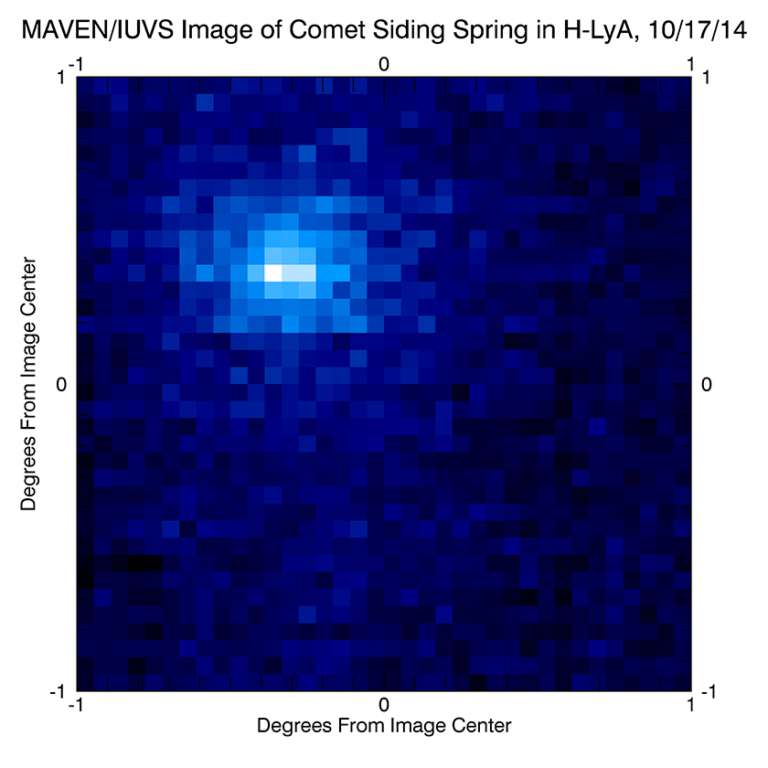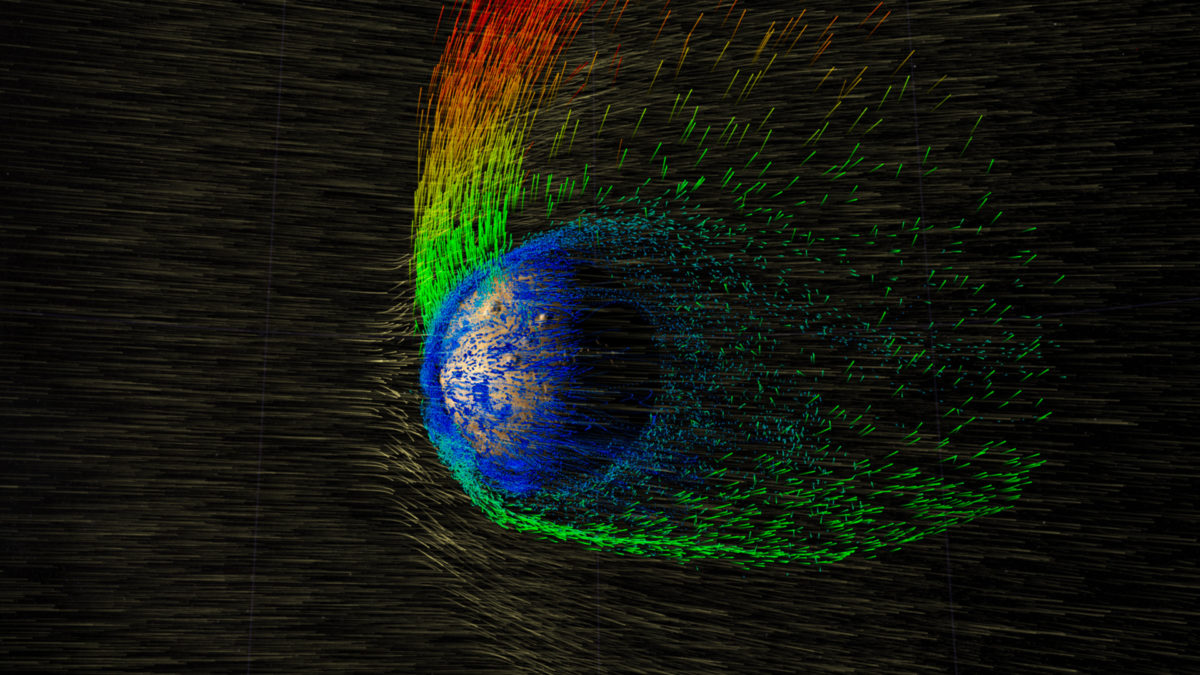Bruce Jakosky • Jul 27, 2016
What MAVEN Learned and What It Will Do Next
The MAVEN mission to Mars completed its one-Earth-year primary mission in November 2015, is in the middle of its first (relatively short) extended mission that runs through September 2016, and was just approved for a two-year extended mission that runs through September 2018. Now is a good time to take stock of we've learned so far and to describe our plans for the extended mission.
MAVEN is the Mars Atmosphere and Volatile EvolutioN mission. It was designed to look at the composition, structure, and behavior of the Mars upper atmosphere, and to determine how gas is lost from the atmosphere to space. This is important in trying to understand what drove the changes that we infer occurred in the Mars climate – the planet's geology tells us that liquid water was present early in Mars' history, but the planet is too cold and dry today to allow water to be stable. We think that greenhouse warming from a thick carbon dioxide atmosphere allowed the presence of liquid water. But where did the carbon dioxide go? Where did the water go? We don't see the large surface and subsurface deposits of carbon-bearing minerals that would have to exist if the carbon dioxide went down into the subsurface. Could gas have been lost from the top of the atmosphere to space? How do the Sun and the solar wind drive escape of gas to space, and how much of the atmosphere might have been lost through time? By studying today's upper atmosphere and loss rates, we can learn about the processes that drive gas away. We can then extrapolate to early conditions and learn how much gas might have been lost to space through time.
The Mars science community had recognized for a long time that an upper-atmosphere mission was needed. Individual instruments had made relevant observations on spacecraft before MAVEN, including from Phobos (Russia), Mars Global Surveyor, and the Mars Reconnaissance Orbiter. The Japanese spacecraft Nozomi was intended to study similar properties, but never made it to Mars. The European Mars Express spacecraft made the most-detailed measurements prior to MAVEN. It has generated a decade of observations covering a full solar cycle but focused largely on ion escape only, without getting a full understanding of the current state or the processes driving escape.
During that first year, we made several "first" observations, starting with observing the effects from Comet Siding Spring, which made a close approach to Mars only four weeks after MAVEN arrived there. We identified metal ions in the upper atmosphere that came from incoming cometary debris, meteoritic material that is falling in toward Mars, and a widespread "diffuse" aurora that is different from what had been seen previously from Mars Express. We began working on the MAVEN mission concept in 2003, and we were selected by NASA to be developed for flight in 2008. After a five-year development, MAVEN launched in November 2013. And after a ten-month cruise to Mars, MAVEN went into orbit in September 2014. It took almost two months to get the spacecraft into its mapping orbit, deploy our four booms, and test our science instruments. MAVEN began regular science observations in mid-November 2014. Its orbit takes it from about 150 kilometers to about 6200 kilometers above the surface, with occasional "deep dips" down to 125 kilometers that let it sample the entire column of the upper atmosphere. While this description makes it sound easy, it took a tremendous effort from the development team to design and build a mission, instruments, spacecraft, and operations plan that would give us the science we wanted.

Most importantly, MAVEN has been able to observe the variable energy coming in from the Sun (in the form of solar extreme ultraviolet (EUV) light and the solar wind), the response of the upper atmosphere to it, and the resulting escape of gas to space. Observations made throughout the first year in orbit allowed us to quantify each of these. Observations during solar storms showed that the loss rate appears to have gone up substantially (by maybe 20 times) during these events, even for the moderate storms that MAVEN saw. The rate of loss of gas to space is very small today, only around a couple hundred grams per second; at this rate, it would take a billion years or so to remove the present-day thin atmosphere. But all of the loss processes would have been more significant early in Mars history, when the solar EUV and the solar wind were more intense, so the loss rate would have been correspondingly greater as well. It's clear that loss to space is occurring today and that it must have occurred throughout Mars' history.

Our analyses to use these results to quantify the integrated loss through time are still ongoing. However, they show that loss to space was a major, if not THE major, process by which the atmosphere and climate changed through time. In that sense, interactions with the solar wind were a major driver of climate change and of the "habitability" of Mars (at least by microbes, at the surface).
Everything continues to operate nominally on the spacecraft, and we're now deep into planning for our extended mission. By this fall, we will have observed for one complete Mars year (almost two Earth years). We've been looking at the changes induced by the changing seasons, and we can determine an "annual average" loss rate. But the loss rate depends on the solar inputs, which vary with the characteristic eleven-year solar cycle. By observing for another two years, we will watch as the Sun moves toward "solar minimum", and we'll get a better idea of how things change with the changing solar conditions. By observing for another two years, we also can look at a second Mars year. Mars is well known for having significant year-to-year variability in its atmospheric cycles of dust, water, and carbon dioxide, and we'll be able to see how these translate into variability in the upper atmosphere and in the escape rate. Continuing our present-day observations will help us to understand whether the observations and results to date are representative of the behavior at the current epoch, or if they might represent non-typical behavior.
In addition, we'll be starting up new observations designed specifically to augment and enhance our science return. These new observations include:
(i) Measurements of the upper-atmospheric wind velocity, using the mass spectrometer. These have never been made on a regular basis before, and will help us to define the circulation and dynamics of the upper atmosphere that is such an important controlling factor in driving escape to space.
(ii) Cold-ion outflow. We've seen strong indications that ions are being lost with velocity just above the escape velocity for Mars, about 5 km/s, in addition to loss of more-energetic ions. These not-very-energetic, or cold, ions have not been mapped out before, but could be a large component of the total escape. We've designed observing sequences to look specifically at this outflow.
(iii) Radio-occultation measurements. We've been measuring the electron abundance that controls the behavior of the ionosphere, and will augment this with regular radio observations that provide complementary information. These are made using the radio transmissions between the Earth and the spacecraft, as the spacecraft passes behind Mars as seen from Earth and the radio signals pass through the ionosphere.
(iv) High-resolution measurements of atmospheric nitric oxide. Nitric oxide is a strong indicator of the atmospheric circulation and of coupling between the Martian lower and upper atmosphere. We've demonstrated, and will now implement, high-resolution imaging that will help us understand this coupling.
(v) High-resolution magnetic mapping. We'll take advantage of MAVEN's orbit period passing through a "commensurability" with the planet's rotation period as drag slows it down; MAVEN will complete 16 orbits every 3 Mars days. This will allow us to make repetitive observations of the magnetic-field behavior at almost constant geometry. We'll be able to do high-spatial-resolution mapping of the magnetic field that will complement previous maps of crustal remanent magnetism, and that will also help us to understand the interaction of the magnetized solar-wind with these magnetized crustal regions.
Together with our ongoing mapping measurements, these new observations should give us a tremendously exciting data set that will help us understand the Mars upper atmosphere, ionosphere, and magnetosphere and how they behave. We'll also continue to coordinate with the Mars Express mission, which makes some similar measurements but at a different location; with data from both spacecraft we can separate out time-variable behavior from spatially variable behavior, something that is not uniquely possible from a single spacecraft.
On top of this, there's an aspect of the science that is extremely difficult to predict. We don't think that we've observed all of the types of behavior that can occur in the interactions between the Sun and Mars. By continuing to observe, we expect to see things that we haven't already seen, and to continue to be surprised and enlightened!

The physics and chemistry of the Martian upper atmosphere and its interactions with the Sun sometimes can seem as if it could be appreciated only by experts. However, the connection to climate change, to the geologic evolution of the surface, and to the changes in the habitability of Mars' surface by microbes make it relevant and important to understanding all aspects of the red planet. And, as part of the detailed study of all of the planets in our solar system, we're helping to elucidate the entire range of outcomes possible on terrestrial planets. Our results are even being applied to exoplanets, to understand generically how planetary habitability can evolve and what planetary-system processes can drive it.
The MAVEN spacecraft is now a well-proven and tested robotic explorer whose cumulative measurements and discoveries will enable and enhance future missions to Mars and elsewhere. This promises to be an exciting time of discovery!


 Explore Worlds
Explore Worlds Find Life
Find Life Defend Earth
Defend Earth


